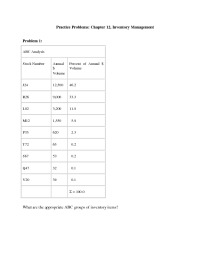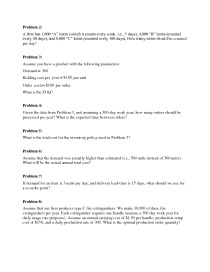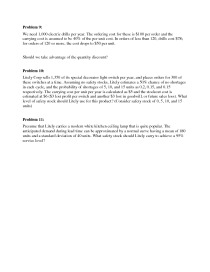Business Inventory Management



Practice Problems Chapter 12, Inventory Management. What are the appropriate ABC groups of inventory items?
Problem 2:
A firm has 1,000 “A” items (which it counts every week, i.e., 5 days), 4,000 “B” items (counted every 40 days), and 8,000 “C” items (counted every 100 days). How many items should be counted per day?
Problem 3:
Assume you have a product with the following parameters:
Holding cost per per unit
Order per order
What is the EOQ?
Problem 4:
Given the data from Problem 3, and assuming a 300-day work year; how many orders should be processed per year? What is the expected time between orders?
Problem 5:
What is the total cost for the inventory policy used in Problem 3?
Problem 6:
Assume that the demand was actually higher than estimated (i.e., 500 units instead of 360 units). What will be the actual annual total cost?
Problem 7:
If demand for an item is 3 units per day, and delivery lead-time is 15 days, what should we use for a re-order point?
Problem 8:
Assume that our firm produces type C fire extinguishers. We make 30,000 of these fire extinguishers per year. Each extinguisher requires one handle (assume a 300 day work year for daily usage rate purposes). Assume an annual carrying cost of $1.50 per handle; production setup cost of $150, and a daily production rate of 300. What is the optimal production order quantity?
Problem 9:
We need 1,000 electric drills per year. The ordering cost for these is $100 per order and the carrying cost is assumed to be 40% of the per unit cost. In orders of less than 120, drills cost $78; for orders of 120 or more, the cost drops to $50 per unit.
Should we take advantage of the quantity discount?
Problem 10:
Litely Corp sells 1,350 of its special decorator light switch per year, and places orders for 300 of these switches at a time. Assuming no safety stocks, Litely estimates a 50% chance of no shortages in each cycle, and the probability of shortages of 5, 10, and 15 units as 0.2, 0.15, and 0.15 respectively. The carrying cost per unit per year is calculated as $5 and the stockout cost is estimated at $6 ($3 lost profit per switch and another $3 lost in goodwill, or future sales loss). What level of safety stock should Litely use for this product? (Consider safety stock of 0, 5, 10, and 15 units)
Problem 11:
Presume that Litely carries a modern white kitchen ceiling lamp that is quite popular. The anticipated demand during lead time can be approximated by a normal curve having a mean of 180 units and a standard deviation of 40 units. What safety stock should Litely carry to achieve a 95% service level?
- Business & Entrepreneurship Papers
- Microsoft Word 31 KB
- 2021 m.
- English
- 7 pages (762 words)
- School
- Ava

















